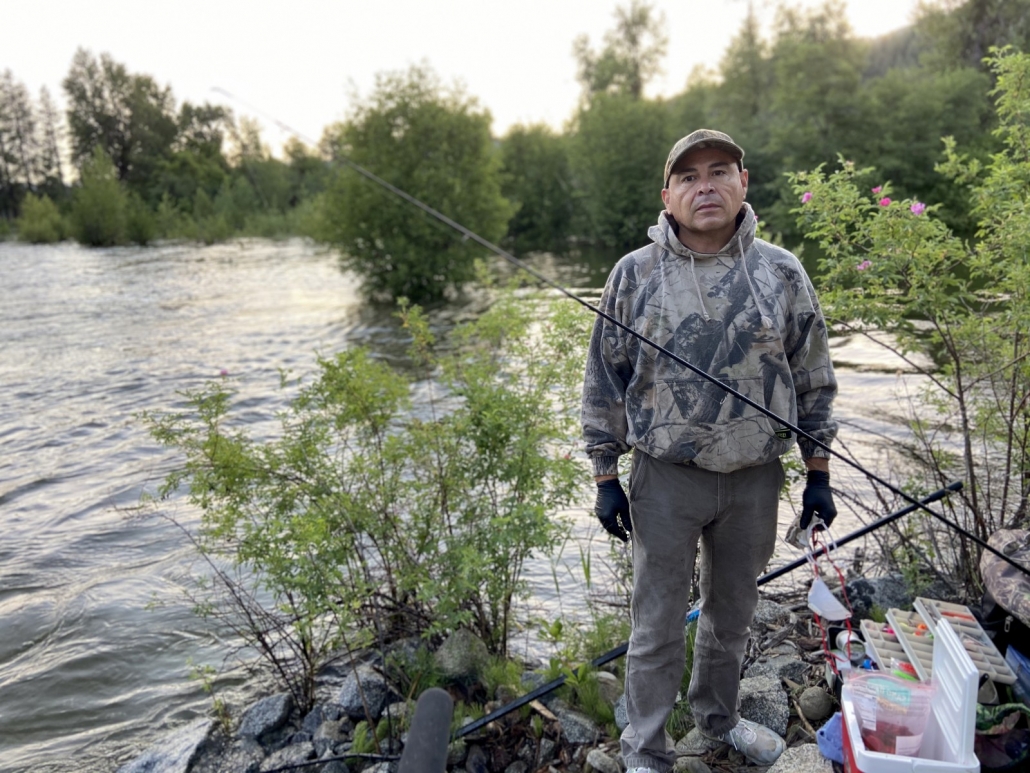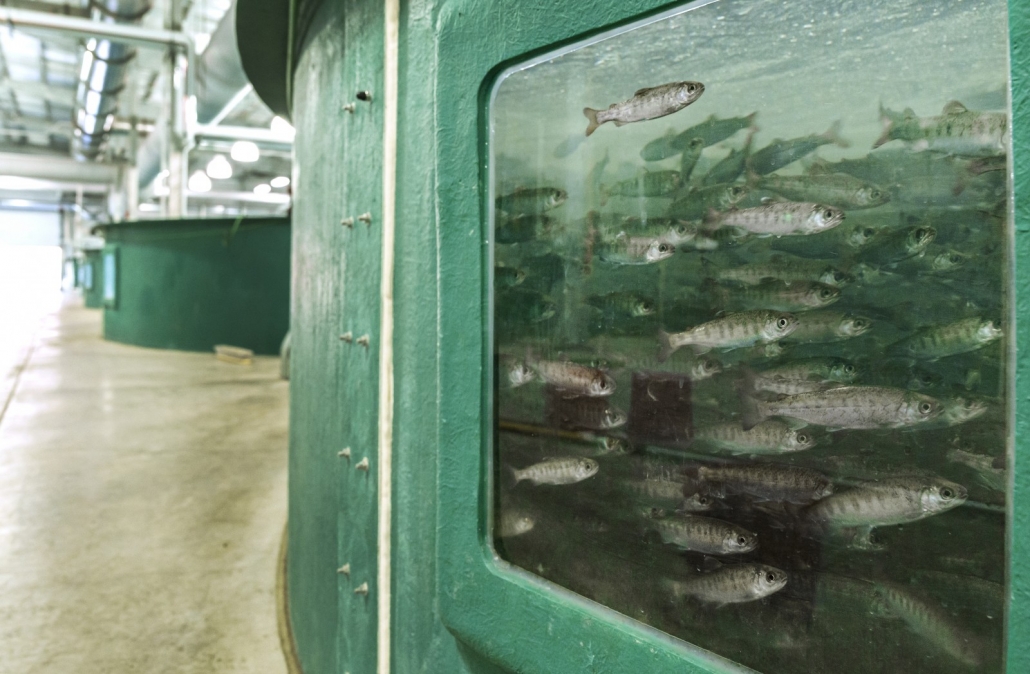The U.S. government promised Native tribes in the Pacific Northwest that they could keep fishing as they’d always done. But instead of preserving wild salmon, it propped up a failing system of hatcheries. Now, that system is falling apart.
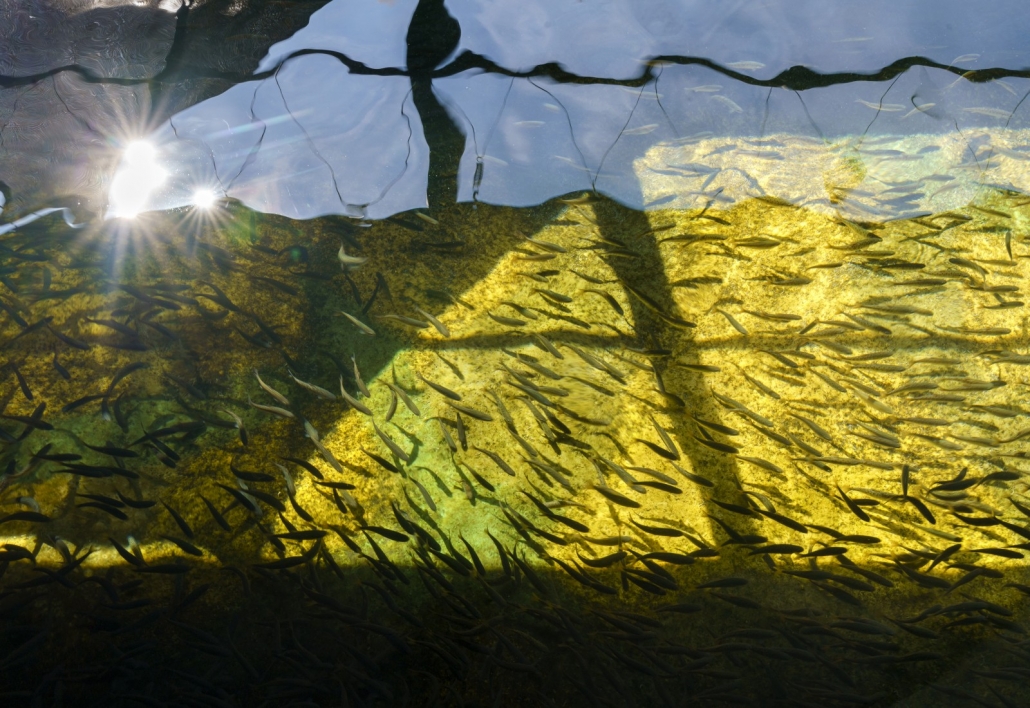
Hatcheries like the Carson National Fish Hatchery, pictured here, breed millions of salmon and let them grow until they are mature enough to be released so they can try to swim to the ocean.
By Tony Schick, Oregon Public Broadcasting, and Irena Hwang, ProPublica
This story was originally published by ProPublica.
CARSON, Wash. — The fish were on their way to be executed. One minute, they were swimming around a concrete pond. The next, they were being dumped onto a stainless steel table set on an incline. Hook-nosed and wide-eyed, they thrashed and thumped their way down the table toward an air-powered guillotine.
Hoses hanging from steel girders flushed blood through the grated metal floor. Hatchery workers in splattered chest waders gutted globs of bright orange eggs from the dead females and dropped them into buckets, then doused them first with a stream of sperm taken from the dead males and then with an iodine disinfectant.
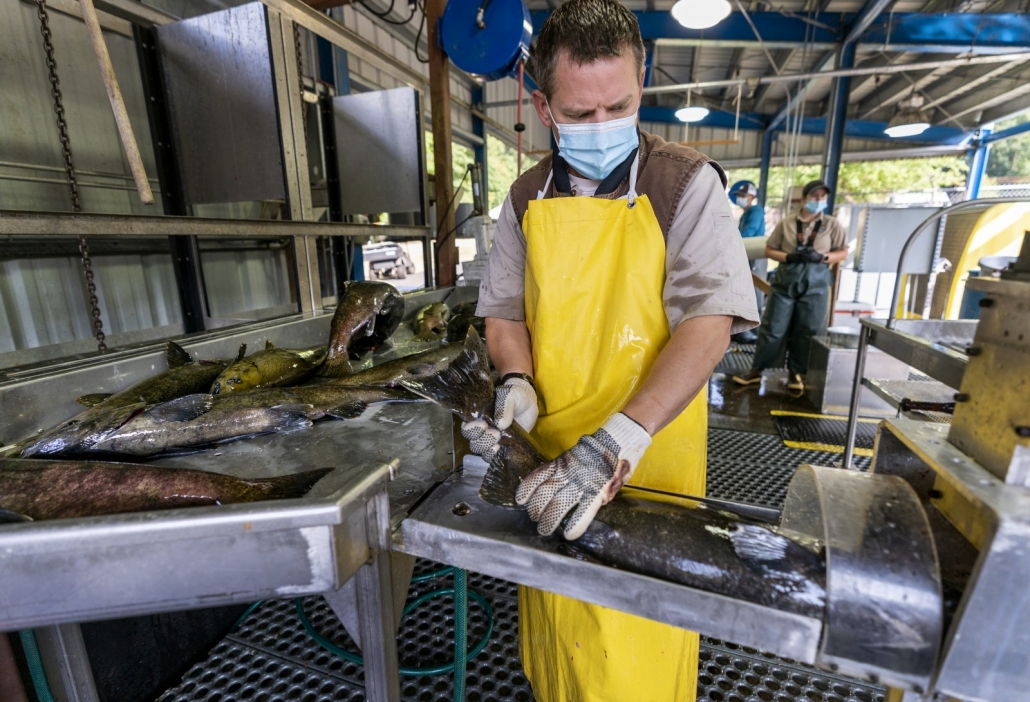
Salmon at the Carson hatchery are moved toward a guillotine during the process of harvesting their sperm and eggs, which will be used to breed more than a million baby fish.
The fertilized eggs were trucked around the corner to an incubation building where over 200 stacked plastic trays held more than a million salmon eggs. Once hatched, they would fatten and mature in rectangular concrete tanks sunk into the ground, safe from the perils of the wild, until it was time to make their journey to the ocean.
The Carson National Fish Hatchery was among the first hatcheries funded by Congress over 80 years ago to be part of the salvation of salmon, facilities created specifically to replace the vast numbers of wild salmon killed by the building of dozens of hydroelectric dams along the Northwest’s mightiest river, the Columbia. Tucked beside a river in the woods about 60 miles northeast of Portland, Carson has 50 tanks and ponds surrounded by chain-link fencing. They sit among wood-frame fish nursery buildings and a half-dozen cottages built for hatchery workers in the 1930s.
Today, there are hundreds of hatcheries in the Northwest run by federal, state and tribal governments, employing thousands and welcoming the community with visitor centers and gift shops. The fish they send to the Pacific Ocean have allowed restaurants and grocery seafood counters to offer “wild-caught” Chinook salmon even as the fish became endangered.
The hatcheries were supposed to stop the decline of salmon. They haven’t. The numbers of each of the six salmon species native to the Columbia basin have dropped to a fraction of what they once were, and 13 distinct populations are now considered threatened or endangered. Nearly 250 million young salmon, most of them from hatcheries, head to the ocean each year — roughly three times as many as before any dams were built. But the return rate today is less than one-fifth of what it was decades ago. Out of the million salmon eggs fertilized at Carson, only a few thousand will survive their journey to the ocean and return upriver as adults, where they can provide food and income for fishermen or give birth to a new generation.
Federal officials have propped up aging hatcheries despite their known failures, pouring more than $2.2 billion over the past 20 years into keeping them going instead of investing in new hatcheries and habitat restorations that could sustain salmon for the long term. At the largest cluster of federally subsidized hatcheries on the Columbia, the government spends between $250 and $650 for every salmon that returns to the river. So few fish survive that the network of hatcheries responsible for 80% of all the salmon in the Columbia River is at risk of collapse, unable to keep producing fish at meaningful levels, an investigation by Oregon Public Broadcasting and ProPublica has found.
These failures are all the more important because hatcheries represent the U.S. government’s best effort to fulfill a promise to the Northwest’s Indigenous people. The government and tribes signed treaties in the 1850s promising that the tribes’ access to salmon, and their way of life, would be preserved. Those treaties enshrined their right to fish in their “usual and accustomed places.” The pacts between sovereign nations did not stop the U.S. from moving forward with a massive decades-long construction project in the middle of the 20th century: the building of 18 dams that transformed a free-flowing river into a machine of irrigation, shipping and hydroelectric power.
The dams meet nearly 40% of today’s regional electricity needs. But they decimated wild salmon.
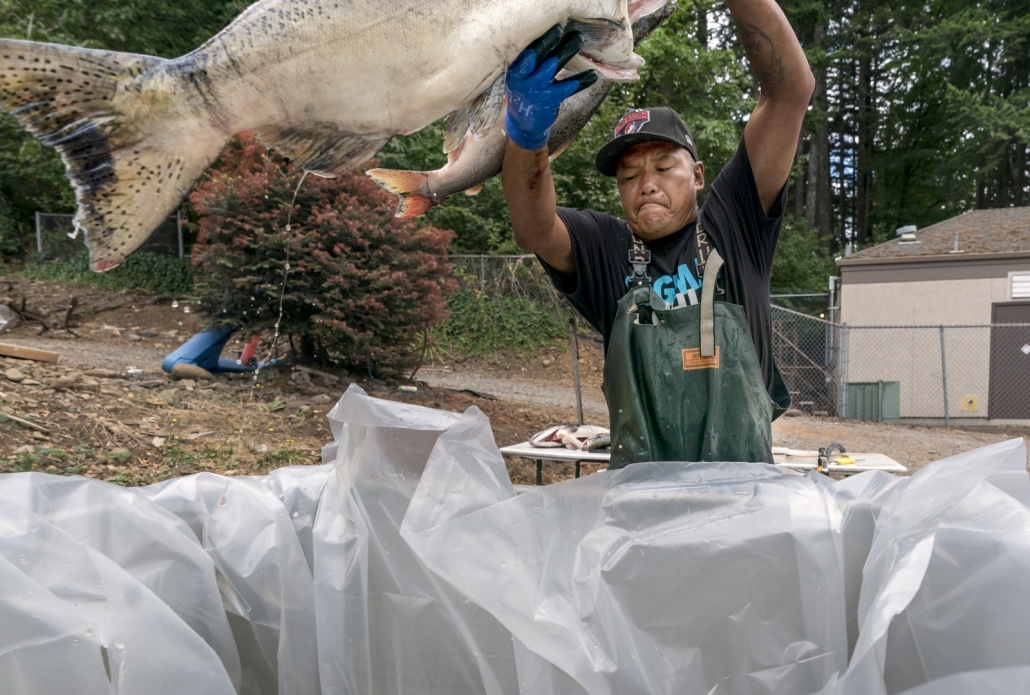
Otis Johnson processes freshly caught salmon at a roadside fish stand last August. Johnson, who grew up on the Warm Springs Reservation, said fishing reminds him of his mother’s tribal traditions and it “keeps me out of trouble. The fish keeps me in a good way and they take care of me. They’re very sacred.”
Many species of salmon are at or near their lowest numbers on record. Native fishermen say their way of life has been stolen from them and from future generations. But the government didn’t invest in making hatcheries better equipped to grow more resilient and abundant stocks. Instead, officials ushered in endangered species restrictions. They knew that hatchery fish were genetically weaker than wild salmon, so they put limits on the number of hatchery fish that could be released into rivers, where they might spawn with wild fish and weaken the gene pool. These restrictions hampered the productivity of the hatcheries, squeezing tribal fishing even more.
In recent years, salmon survival has dropped to some of the worst rates on record. The numbers of returning adult salmon have been so low that dozens of hatcheries have struggled to collect enough fish for breeding, putting future fishing seasons in jeopardy.
“A Finger in a Dike”
There are many reasons that Columbia River salmon die, whether they were born in the wild or in hatcheries. Millions don’t survive their trip down the river, which has become a gantlet of dams and slackwater reservoirs, hot and polluted waters, and invasive predators. Millions more die in the ocean or get snared by commercial fishing ships, ending up as grocery fillets or pet food before they can return upriver toward their spawning grounds.
Some die-off is natural. But the dismal survival rates of salmon bred on the Columbia today are neither natural nor sustainable.
Oregon Public Broadcasting and ProPublica examined the yearly survival of eight Columbia River Basin hatchery populations of vulnerable salmon and steelhead trout, detected at a federal dam on their way out to sea as juveniles and on their way back upriver as adults. This dam-to-dam measure provides one of the only consistent indexes of how well salmon are surviving. But it’s a high-end estimate, because it only measures how well they’re surviving in the ocean. These numbers don’t account for the millions of juvenile fish that die migrating downriver before they’re counted at the dam or the many adults who pass the dam but die before reaching their destination upriver. Our analysis of the publicly available data provides a high-level and easily understandable snapshot of hatchery performance; previously, assessing the health of the hatchery system would have required combing through thousands of pages of government reports and academic research.
Even with this generous estimate, however, the survival rates of these hatchery fish have been well short of the established goals for rebuilding salmon populations, according to the Oregon Public Broadcasting and ProPublica analysis.
According to our analysis, salmon populations released from 2014 to 2018, the most recent years for which complete data was available, had some of the worst survival rates on record. In that time period, none of the eight populations had average returns exceeding 4%, the threshold necessary for a population to recover, which was adopted by the Northwest Power and Conservation Council and vetted by independent panels of experts. But even in the previous six years, when ocean conditions were favorable for salmon, only two achieved average returns above 4%.
That 4% goal was established for wild populations, but in a 2015 report to Congress, 17 scientists recommended that survival rates of hatchery fish would have to be high relative to wild fish “to effectively contribute to harvest and/or conservation.”
Most hatcheries, however, aren’t even aiming to meet the council’s recovery goals. Some aim to get less than half a percent of their fish back. But lately, they aren’t even getting that.
“It’s not self-sustaining. We don’t have the numbers,” said Aaron Penney, a member of the Nez Perce who spent more than 20 years managing his tribe’s hatchery on the Clearwater River in Idaho. Penney, now a biologist for the Coeur d’Alene Tribe in northern Idaho, says raising hatchery fish in worsening river and ocean habitat is like “putting a finger in a dike to stop a leak.”
Records obtained from NOAA show that over the past five years, dozens of hatchery programs have fallen short of their typical production levels, some by more than half. Some have tried to address that shortfall by capturing more wild fish to breed. Others used eggs that were shared by nearby hatcheries.
But major shortages across the Columbia basin in 2018 and 2019 left hatcheries scrambling to find enough egg-bearing female fish. Tribal hatcheries, which are located farther upriver where salmon face a longer, harder journey, bore the brunt. They’ve been planning for shortages to become commonplace as rivers and the Pacific Ocean get hotter.
In 2019, Idaho’s Nez Perce Tribe needed an influx of hundreds of fish from hatcheries 300 miles away in Washington to keep breeding salmon. Staff at the time called it a “dire emergency.”
In central Washington, the Yakama Nation’s share of eggs was so small that its hatchery on the Klickitat River was down to 30% of the number of fish it usually raises.
“It’s impacting the Indians a lot, man,” said Shane Patterson, a member of the Yakama Nation who fishes the Klickitat and works as a catch monitor for the tribe. “The seasons ain’t as long as they used to be, they’re smaller runs, everything.”
Between spring and fall, Patterson and his friend and fellow tribe member Chance Fiander spend evenings atop plywood scaffolds built into the rock face of the Klickitat River canyon, plunging dip nets 30 feet into the waters, awaiting the jolt of a salmon fighting its way upstream.
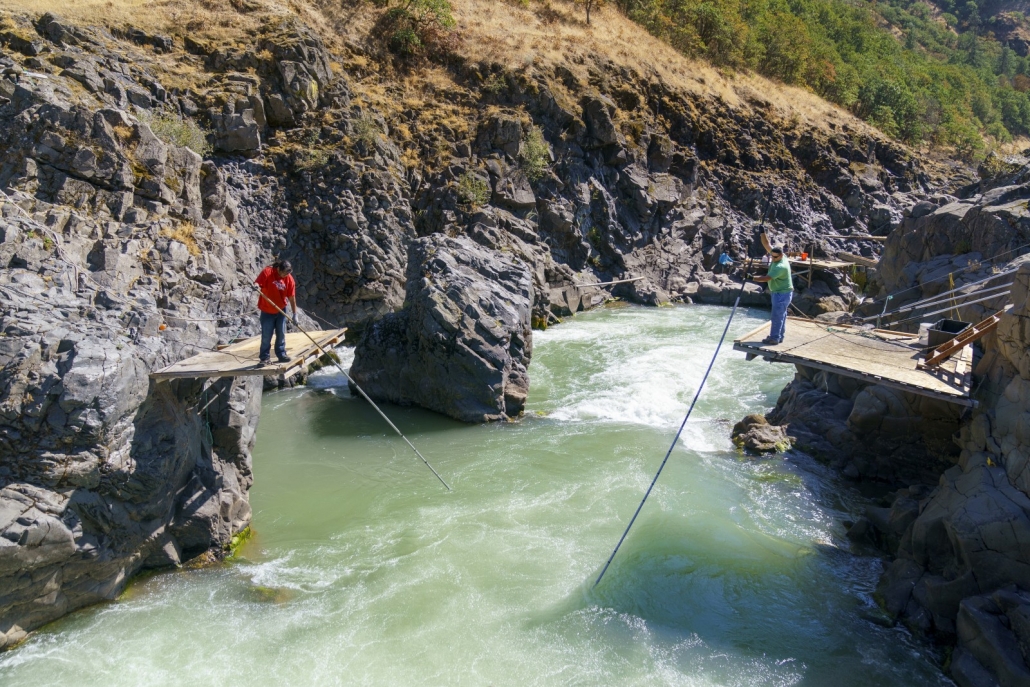
Shane Patterson of the Yakama Nation, right, uses a dip net to fish for salmon on the Klickitat River. He said a lot of people rely on fishing for income and to feed their families. “And it just ain’t like it used to be,” he said.
The Klickitat hatchery provides Patterson and Fiander fish to catch for their families and for the tribe’s longhouses, spiritual gathering centers that need salmon for weekly ceremonies, annual feasts, funerals and coming-of-age ceremonies known as name givings.
This April, there were so few spring Chinook salmon for the annual spring feast Patterson attended — held to honor the first foods of the new year — that it took donated bags of frozen salmon to feed everyone at the longhouse that day.
Barry Berejikian, the top hatchery scientist at NOAA’s Northwest Fisheries Science Center, agrees. He points to changes in fish tanks, water temperature and feeding schedules that can all increase hatchery fish’s survival odds. Facilities could also adjust how many fish are released and when: Longtime hatchery philosophy has been to flood the river with fish. But scientists have found that overloading the environment with too many fish can slow population growth, and that varying release times gives fish a better chance of survival.
As climate change damages the habitats of wild salmon, hatchery fish become all the more important.
“As we increasingly rely on them, we need to do them better,” Berejikian said of hatcheries. “Right now, the emphasis is not there.”
Officials at federal agencies governing hatcheries said they know salmon survival needs to improve, but demurred when asked about adopting the strategies Berejikian mentioned.
Most production at the 13 hatcheries run by the Fish and Wildlife Service is governed by legal agreements or settlements, giving the agency little flexibility, spokesperson Brent Lawrence said. He touted the agency’s success in keeping fish alive while they’re at the hatchery and said that fish survival in the wild is largely outside the agency’s control.
“We strive to release the healthiest salmon possible from our hatcheries to give the fish the best chance of survival,” Lawrence said.
Guy Norman, chair of the Northwest Power and Conservation Council, acknowledged changes are needed at hatcheries to produce stronger fish. But the council’s latest program called for no such changes. Norman said the council would help facilitate research and improvements, but that it has a limited role in prescribing operations at the state and tribal hatcheries in its program. However, the council has ordered changes in the past, such as stipulating that all hatcheries funded through its program needed to follow recommendations for protecting wild salmon.
Purcell, the NOAA hatcheries official, said her agency is limited in what it can require of hatcheries if the changes aren’t directly impacting an endangered population. And, because most of the region’s hatchery facilities are between 40 and 100 years old, she said recommended improvements like more natural rearing conditions “are not an option without a major rebuild.”
According to documents obtained from NOAA, much of the Columbia River Basin’s hatchery tanks and rearing facilities are near the end of their lifespans, and the basin’s capacity for hatchery production has diminished as failing infrastructure has been decommissioned or put into limited operation.
“That creates a lot of limitations to what we can implement,” Purcell said.
Existing operations at Northwest hatcheries are already underfunded by hundreds of millions of dollars, and in some cases parts of their infrastructure have literally crumbled and killed thousands of fish in the process.
At the Lookingglass Hatchery in northeast Oregon, outdated concrete “fish ladders” meant to help salmon escape upstream to spawn are instead blocking them, but the hatchery doesn’t have the $3.4 million needed to fix the problem. Meanwhile, the Lyons Ferry Hatchery in southeast Washington lost 250,000 fish this year because of a crumbling rubber gasket. Last year, it spent more than $5 million on a burst pipe and a pump failure.
In all, records show staff at federally funded hatcheries have identified more than $320 million in repairs and equipment upgrades they can’t make unless the government provides funding.
Congress has kept hatchery funding essentially flat for more than a decade, leaving those needs unaddressed. Sen. Maria Cantwell, a Democrat from Washington, sought to include $400 million for hatcheries as part of President Joe Biden’s Build Back Better plan. It would have been the single largest expenditure on hatcheries ever. That effort failed along with the bill. Cantwell did not respond to requests for comment.
Overhauling hatcheries to withstand climate change will cost hundreds of millions more. For instance, the Fish and Wildlife Service predicts that warming waters will lead to more disease and harm the growth of its fish, and that droughts could lead to water shortages on site. The agency has not yet requested additional funding to address what it calls “climate vulnerabilities” at Leavenworth or elsewhere.
More than a decade ago, Whalawitsa and his son Chris began fishing beside the Leavenworth National Fish Hatchery, where the current system only supports about half the promised production levels.
Whalawitsa and Chris fish hook-and-line by day and with traditional dip nets all night, trying to fill orders for tribal elders, family members and sick neighbors to help sustain them through winters on the reservation.
“We’re doing the best we can to keep this alive,” Whalawitsa said. “All I can do is pray and hope that this gets better because I want to see my grandchildren fish this.”
When they first started, they’d easily fill five coolers in a single trip and end up racing back and forth to the reservation to make room for more.
Now, they say, they’re lucky to fill one.
About the Data: How We Analyzed Salmon and Steelhead Trout Survival
Oregon Public Broadcasting and ProPublica obtained data from Columbia Basin Research at the University of Washington describing fish in several salmon and steelhead trout populations that were embedded with electronic tags. Tagged fish can be detected by special technology, often at dams, and tag data can provide a window into fish migration and survival. Our approach took a basin-wide view of the hatchery program to create a meaningful, accessible and representative picture of hatchery efforts to support vulnerable salmon and steelhead populations in the region.
We focused our analysis on eight fish populations, all of them Columbia River Basin stocks that are highly vulnerable and monitored by the National Oceanic and Atmospheric Administration with the goal of restoring populations to healthy and harvestable levels. Focusing on fish populations that originated in the middle and upper Columbia and Snake rivers had two benefits: First, these were areas that were significantly impacted by the building of hydropower dams in the basin, and second, these were regions for which data was available. The upper Columbia River spring Chinook and Snake River sockeye populations are listed as endangered under the 1973 Endangered Species Act. The Snake River fall Chinook, Snake River spring/summer Chinook, Snake River steelhead and upper Columbia River steelhead populations are listed as threatened. The Mid-Columbia Coho Restoration Program includes all coho released in the Wenatchee and Methow basins, and the population was considered by NOAA for designation as threatened or endangered, as were upper Columbia River summer/fall Chinook; though these populations ultimately were not listed, they are still monitored by Columbia Basin Research and NOAA. These eight monitored populations are supported by more than 30 artificial propagation programs along the Columbia River and its tributaries.
The University of Washington’s Columbia Basin Research center provides data about these eight populations at any one of three federal dams: Bonneville Dam, Lower Granite Dam and McNary Dam. The tags, called passive integrated transponders, help generate data including the number of tagged juveniles released each year on their outbound journey downriver and the number of fish from each release year that were later detected as adults returning upriver from the ocean. Comparing these two quantities taken at Bonneville Dam, the nearest dam to the ocean on the Columbia River, provides an estimate of how many fish survived the ocean.
We calculated survival rates across two time periods: 2008-2013 and 2014-2018. During the first period, coastal conditions and climate conditions in the Pacific Ocean were particularly favorable for salmon and steelhead trout. Conditions changed around 2014, the beginning of our most recent span of data. Though Chinook, coho, sockeye and steelhead trout all mature at different times and follow distinct migration patterns, the majority of adult fish from these species return to fresh water to spawn after four years in the ocean, which is why we ended our analysis with the 2018 population: Any juveniles released after that may not yet have had time to return as adults, so that was the most recent population for which data was reliable.
We compared survival rates to benchmarks established by the Northwest Power and Conservation Council. In 2003, the council set a goal of 4%, on average, of all juvenile salmon who headed for the ocean would return to fresh water as adults, although it allowed for a range of between 2% and 6% annually. According to the council, these rates should be sufficient to ensure the recovery of the salmon species that are listed as endangered and to help reach the council’s goal of 5 million total salmon and steelhead returning to the Columbia and its tributaries each year. We used this approach for a couple key reasons. While individual hatcheries assess their programs using a variety of measures, we found that these assessments aren’t standardized and very few people are looking at the overall success of the hatchery system; the 4% benchmark allows us to look at the health of the system as a whole. We also listened to the advice of experts in looking at the data across multiple years because the results from any given year are too volatile to be meaningful.
In 2008-2013, only two of the eight populations we examined had average returns exceeding 4%: mid-Columbia coho and Snake River fall Chinook. In 2014-2018, none of the populations had average returns exceeding 4%. For the statistically minded, some further notes: To characterize the uncertainty in average survival rates for the two time periods, we ran bootstrapping experiments on the data using 1,000 trials within each time period to calculate 95th percentile confidence intervals around the bootstrap mean. The confidence intervals for three additional populations (Snake River spring/summer Chinook, upper Columbia River summer/fall Chinook and upper Columbia River steelhead) included the 4% recovery goal between 2008 and 2013. Between 2014 and 2018, the confidence interval for one population, the mid-Columbia coho, included the 4% minimum threshold.
It is important to note that fish biologists evaluate salmon and trout using a variety of performance indicators and metrics, with ocean survival being only one of them. Other metrics include the total number of juvenile fish released by hatcheries, the total number of adult fish returning to fresh water, the proportion of adult returns that started as hatchery juveniles, the state of local habitats, and even fish genetics. However, many of these measures are complex and difficult to compare across a variety of fish management practices, geographies and fish populations. By contrast, estimates of survival are readily available and offer a relatively holistic picture of how a population is doing. They also allow us to see the return on investment of the resources that have been allocated to hatcheries programs — a crucial measure given the limited amount of money available for this effort.
This estimate of ocean survival has some caveats. Only a portion of the salmon released each year are tagged. Furthermore, only a fraction of juvenile salmon survive the journey from release sites far upstream of Bonneville to the dam, and not all adult salmon that make it to Bonneville on the return trip will survive the full freshwater journey back through the hydropower system. That means the estimates drawn from these numbers are generous — the highest that they’ll be on the journey upriver. Nevertheless, these ratios of adult to juvenile tag detection can be considered an index that reflects the trends in populations that can be compared across species, migration patterns and release sites.

